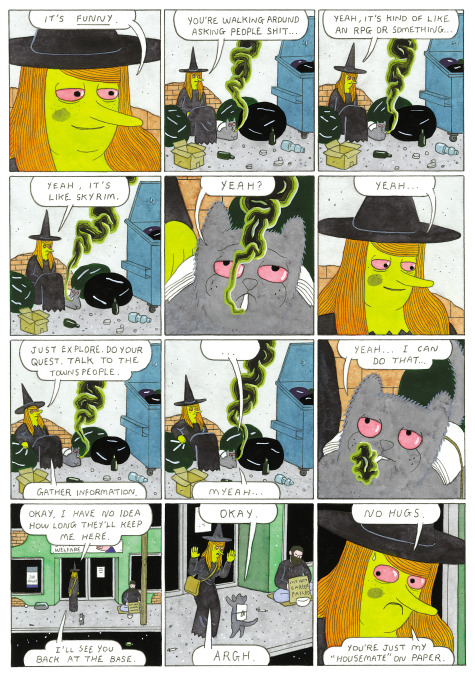Bad Gateway finds itself by refusing to let readers look away from uncomfortable truths

Some comics have both the good fortune and burden of being wholly unfamiliar in form and tone to readers. Bad Gateway is definitely one of those, a book specifically and clearly rooted in the comic-book storytelling tradition but which differs wildly from the average superhero tale or graphic memoir. The book focuses mostly on Megg, a young woman with the green skin, long nose, black dress, and hat of the Wicked Witch of the West, as well as her boyfriend Mogg and several of their friends. Creator Simon Hanselmann has made three other books about these characters, but it’s easy to jump in with this one—in no small part thanks to a short summary of the gang’s adventures on a double page spread that opens the book.
Hanselmann’s visual style straddles an interesting line between cartoonish and raw; Megg’s design clearly leans into the former. Mogg is a literal cat, and their roommates have included a man-sized owl named Owl and a drug dealer named Werewolf Jones. But there’s a visual focus on drug use (and the lengths to which Megg and Mogg in particular go to get more drugs), and the pages fill up with the sight of their filthy apartment, sex, and sorrow. The juxtaposition is a fascinating one, and part of what makes Hanselmann’s work so compelling. There are comics and graphic novels that parallel Megg’s story, but the bright colors and deceptively simple character designs make it feel like all of the struggle and pain could turn around at any moment, a heavy contrast with the methodical unraveling of Megg’s life. Drug use and sex are portrayed with the same frankness as simple nakedness, messy babies, and flashes of underwear when people are less than graceful. The characters may seem simple, but Hanselmann’s work is detailed and painterly, and the backgrounds feature a lot of fine, subtle colors and textures that make Megg’s world and her struggles all the more real.
None of the characters in Bad Gateway feel particularly sympathetic (or unsympathetic) at the outset of the book. There’s a lot of resentment between them, a lot of mistakes and hurt feelings. Few of them are doing anything to resolve this. But Megg’s plight is one that will be familiar to a lot of folks coming up after baby boomers, struggling with the weight of a world on fire and turning to substances for relief and release. None of the mistakes that have been made at that point feel like anything particularly dastardly or inhuman. Just as with his art, Hanselmann creates a delicate balance—between feeling for Megg and her friends because they seem to be caught in a cycle of substance abuse and poverty, but also being frustrated at the way they so frequently abdicate their own responsibilities.
What really drives Bad Gateway forward, and makes it a worthwhile read, is the vulnerability that each character displays. It’s a raw and flayed kind of storytelling, each struggle arriving like a new wound on top of an old bruise. Each character is trapped in a reality of their own making, and none of them can seem to find any way out, and that’s if they have the awareness to realize they might want to. Even for readers who haven’t been in Megg’s exact position, that’s a feeling that translates and lingers long after the book ends. The best way to describe Hanselmann’s work here is “tender,” which may be a surprise to some readers given the subject matter. Bad Gateway is honest about the shortcomings of human beings, but it’s tender to Megg especially, making space for her to feel and do what she needs to in order to survive.
